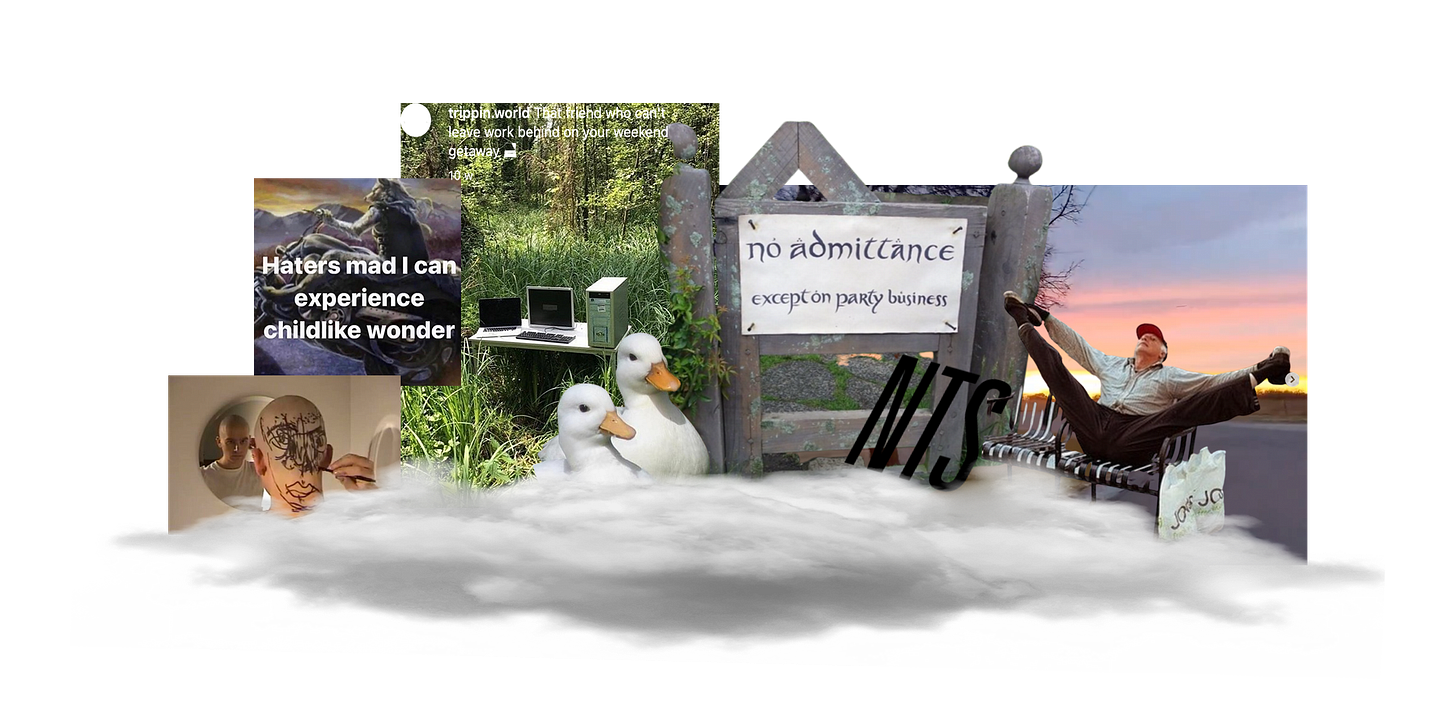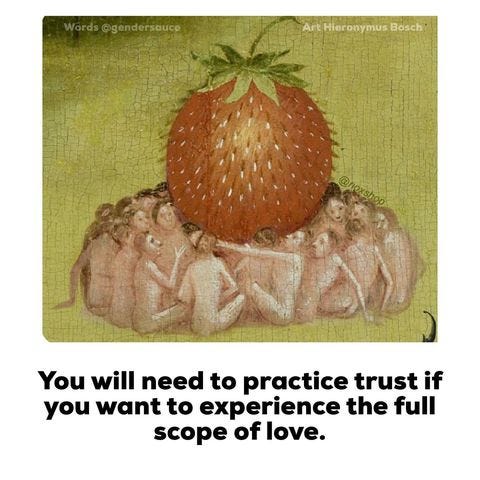019 - S.O.S = Soothe Our Souls
The new era of comfort content is designed to be dream-nourishing, not mind-numbing
Regular readers know the drill: everyone is sick of modern life and all the stress that comes with it. Gen Z are rallying against capitalism, dystopian aesthetics are everywhere, and we’re seeing a nihilistic vibe shift away from millennial sincerity and towards irony and playfulness (we’ll say it again, better laugh or you’ll cry).
But there’s flipside to all that: An equally anti-capitalist, but altogether cosier new school of comfort content, which is taking over our social feeds one fluffy duckling at a time. What does that mean for us and our psyches? Quite a lot, it turns out. Read on as Dalia Al-Dujaili, editor of Azeema, investigates…
“No more girlbossing,” the now-iconic meme announces, “just girlresting girlsleeping girllayingdown etc”. And thus was born a new era of comfort content.
Unlike comfort content classics of years gone by (think brightly-coloured trash tv, ASMR, cooking videos, make-up tutorials, internet shopping sites), which work by numbing your brain into peacefulness, this new form of social media content is actively nourishing: evoking a return to paradise, heightening our spirituality, encouraging us all to enter our anti-grind era.
Capitalist fatigue has led us to a point wherein we are all nostalgic for childhood innocence and a lack of responsibility. Given the stress of modern life (a cost of living crisis, climate disasters, global conflicts…) it’s no surprise. I’m tired, you’re tired, we’re all tired. And no, I’m not deficient in whatever vitamins you’re trying to sell me. The purpose of comfort content is to remedy hyper-individualistic, materialistic and mechanised lifestyles of 21st century western hegemonic culture. The trend is so noticeable that the New York Times is reporting on ‘comfort creators’.
It was Anne Helen Peterson’s viral 2019 essay that first coined ‘millennial burnout’, perfectly timed before the pandemic forced an entire generation to press pause. But post-pandemic, the stresses of modern life persist: Alongside growing feelings of nihilism and anti-capitalism, we’ve seen a slew of trends that speak to our desire for a slower pace of life: cottagecore, cult reads about rest (see: Ottessa Moshfegh’s My Year of Rest and Relaxation, Adrienne Maree Brown’s Pleasure Activism and more recently Tricia Hersey’s Rest is Resistance), plus the recent boom in comfort-themed memes.
In short: Gen Z is over the grind. Comfort content reminds us of the little simple joys in life at a time when life seems overwhelmingly difficult, tiresome and negative.

But what exactly does this new era of comfort content look like? Here are the most distinct categories
Animals and nature
I see this genre of comfort content as an attempted antidote to our yearning for a pre-industrial era, and lessons for the ecological crisis. This 51 second video of a little lamb has racked up a whopping 39 million views. “i didn’t expect my video to get so many views,” creator Lee says in the comments. Lee, my brother, you published your video at the beginning of a global pandemic. “Sunny, quiet, peaceful, and a little lamb to pet. I am unreasonably jealous,” says another comment. Couldn’t agree more, @louisbowels6858. But no other lockdown video can quite compare to the masterpiece that is ‘Mobbed by Racoons Tuesday Night’.
Storybooks, fairytales and magic
This is my personal favourite. See: exhibit a, exhibit b and exhibit c. This type of comfort content tries to fill the gaping hole left from childhood, when we believed in magic, fairies and read stories about beavers in waistcoats. I think this is the best kind of comfort content because it ticks many of the boxes; nature, nostalgia, anti-grind, aesthetics, and community.
Old people and loved-up couples
The dream of a restful, responsibility-free retirement is as desirable as a return to childhood innocence, yet a dream that seems more radical by the day (see: France, protests, etc). The in-love (and here), too, present us with a deep yearning and desire for human intimacy and connection that many are finding increasingly difficult to maintain.
Beds and rest
The fantasy of a deep sleep. (a, b, c, d, e)
Food for thought
Then there’s the meme accounts: a new generation of creators like @affirmations, @spriteismadebyfairies, @hornytherapy and @gendersauce, who are all making content designed to massage both the brain and the soul, with whimsical, often nature-based imagery and spiritual messaging that speaks to the new-gen frame of mind: thoughtful, self-aware and community focused.
The irony is clear – as capitalism continues to inflame our societal and planetary issues daily, brand visuals have increasingly focused on natural, spiritual and community focused messaging to counteract the mechanised, homogenous and individualistic realities of western consumer-based culture.
Selling the dream
Brands selling the comfort dream include classic cottagecore girlies like Damson Madder, Meadows, Loveshack Fancy, Christy Dawn and Doen. These brands want to make us feel like we’ve just returned to our cabin in the woods with a basket of freshly picked raspberries, and not like we’ve just stepped off public transport into an increasingly polluted city. Then you have the ‘return to Mother Earth’-type brands like Hara the Label and Nisa that use the au naturale feminine figure to represent creativity, nature and community.
Free People and For Love & Lemons are examples of fast fashion which ride this wave quite well, peddling the ‘slow life’ whilst they practise a darker reality, churning out tons of waste at the expense of both underpaid Global Majority women workers, and the planet (you can helpfully check brand ethics ratings at Good on You).
But ultimately, if you’re selling crap, and you’re selling a lot of it, chances are your audience will see right through you. Which brings us to…
A new way to brand
Brands that make us feel comforted, safe and, most importantly, seen are on the rise and performing better. The urge to document our lives in an ‘algorithmically optimizable’ way is on the decline. A style of social posting and influencing popularised by Emma Chamberlain which publications and platforms like The Cut have adopted to keep engagement high via ‘chill celeb’ pics complemented by poetic captions like ‘our cool, slutty daddy’.
Gen Z, as we all know, don’t like try-hard. This means brands need to stop trying so hard to be ‘chill’. They just need to actually chill. Venkatesh Rao made a prediction in 2019 that “If Millennials were the premium mediocre generation, Gen Z is going to be the domestic cosy generation… Premium mediocre looks outward with a salesman affect, edgy anxiety bubbling just below the surface. Domestic cosy looks inward with a relaxed affect.”

contrast to millennial comfort brands like Glossier, the likes of NTS and Trippin’ are appealing to a certain slouchy and laidback Gen Z sensibility. From low-fi obscure imagery that vaguely references some fringe music sub-genre, to the magical, natural and spiritual, NTS knows exactly how to make its audience feel like it’s cool enough to be trusted. Whereas Trippin’ loves to share comforting moments of joy from Global Majority communities, encouraging a ‘logging off’ approach to community building, whilst leading the way for making products actually mean something. Oh, you wanna sell a jacket, North Face? Tell me how this jacket is going to help me climb a mountain with my friends, because that’s what I’m into now. Meaningful brand partnerships with community, and increasingly nature, at the heart are quickly becoming thee way to market.
“Gen Z is currently the generation most interested in shopping,” reports Vogue Business, but we are more conscious of what we’re buying. We’re more frugal, more sustainability inclined, and more creative with our shopping choices. “[Gen Z] believe that the generations before them represented overconsumption, capitalism and materialism,” says another report from Voyado, Data shows Gen Z still definitely love buying *stuff*. We just don’t want to feel like we’re accumulating stuff for the sake of a well-curated image.
Brands who show that they’re run by actual humans as opposed to AI might be safest, and there are already many that are leading that charge by using their position to create a positive impact - you know who you are.
Where will comfort content go from here?
That all depends on how our old friend Capitalism behaves over time. Wherever there is demand, there is supply – so the deeper we go, the deeper our need for external comfort, until all our comfort is manufactured… what a dark thought. But it’s looking like consumers are cottoning onto the fact that brands will never be able to fill the desire for a comforting life filled with community connection, a return to nature or a deep rest.
Meanwhile, as many brands continue to make the bold steps to deconstruct the slimy ways they can operate, the future is looking brighter. Here’s hoping for a world where small brands can thrive alongside the big ones that commit to doing good, and where we actually have time to ourselves (what a concept!) to seek comfort in the real world, to the point where comfort is no longer a novelty existing solely on screen.
That’s all for today! We hope you enjoyed reading. Feel free to drop us a comment below if you have any thoughts to add 💌 otherwise, chat soon!
Words: Dalia Al-Dujaili
Editor: Letty Cole












(っ-,-)つ🧸🌸☁️
🧚🧚🧚🧚